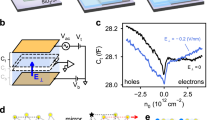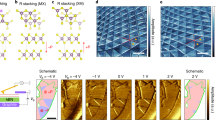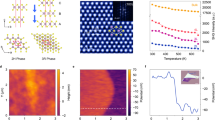Abstract
A ferroelectric is a material with a polar structure whose polarity can be reversed (switched) by applying an electric field1,2. In metals, itinerant electrons screen electrostatic forces between ions, which explains in part why polar metals are very rare3,4,5,6,7. Screening also excludes external electric fields, apparently ruling out the possibility of ferroelectric switching. However, in principle, a thin enough polar metal could be sufficiently penetrated by an electric field to have its polarity switched. Here we show that the topological semimetal WTe2 provides an embodiment of this principle. Although monolayer WTe2 is centro-symmetric and thus non-polar, the stacked bulk structure is polar. We find that two- or three-layer WTe2 exhibits spontaneous out-of-plane electric polarization that can be switched using gate electrodes. We directly detect and quantify the polarization using graphene as an electric-field sensor8. Moreover, the polarization states can be differentiated by conductivity and the carrier density can be varied to modify the properties. The temperature at which polarization vanishes is above 350 kelvin, and even when WTe2 is sandwiched between graphene layers it retains its switching capability at room temperature, demonstrating a robustness suitable for applications in combination with other two-dimensional materials9,10,11,12.
This is a preview of subscription content, access via your institution
Access options
Access Nature and 54 other Nature Portfolio journals
Get Nature+, our best-value online-access subscription
$29.99 / 30 days
cancel any time
Subscribe to this journal
Receive 51 print issues and online access
$199.00 per year
only $3.90 per issue
Buy this article
- Purchase on Springer Link
- Instant access to full article PDF
Prices may be subject to local taxes which are calculated during checkout



Similar content being viewed by others
References
Dawber, M., Rabe, K. M. & Scott, J. F. Physics of thin-film ferroelectric oxides. Rev. Mod. Phys. 77, 1083–1130 (2005).
Scott, J. F. Applications of modern ferroelectrics. Science 315, 954–959 (2007).
Anderson, P. W. & Blount, E. I. Symmetry considerations on martensitic transformations: ‘ferroelectric’ metals? Phys. Rev. Lett. 14, 217–219 (1965).
Shi, Y. et al. A ferroelectric-like structural transition in a metal. Nat. Mater. 12, 1024–1027 (2013).
Benedek, N. A. & Birol, T. ‘Ferroelectric’ metals reexamined: fundamental mechanisms and design considerations for new materials. J. Mater. Chem. C 4, 4000–4015 (2016).
Kim, T. H. et al. Polar metals by geometric design. Nature 533, 68–72 (2016).
Sakai, H. et al. Critical enhancement of thermopower in a chemically tuned polar semimetal MoTe2. Sci. Adv. 2, e1601378 (2016).
Rajapitamahuni, A., Hoffman, J., Ahn, C. H. & Hong, X. Examining graphene field effect sensors for ferroelectric thin film studies. Nano Lett. 13, 4374–4379 (2013).
Huang, B. et al. Layer-dependent ferromagnetism in a van der Waals crystal down to the monolayer limit. Nature 546, 270–273 (2017).
Mak, K. F., Lee, C., Hone, J., Shan, J. & Heinz, T. F. Atomically thin MoS2: a new direct-gap semiconductor. Phys. Rev. Lett. 105, 136805 (2010).
Novoselov, K. S. et al. Two-dimensional gas of massless Dirac fermions in graphene. Nature 438, 197–200 (2005).
Zhang, Y., Tan, Y. W., Stormer, H. L. & Kim, P. Experimental observation of the quantum Hall effect and Berry’s phase in graphene. Nature 438, 201–204 (2005).
Bune, A. V. et al. Two-dimensional ferroelectric films. Nature 391, 874–877 (1998).
Martin, L. W. & Rappe, A. M. Thin-film ferroelectric materials and their applications. Nat. Rev. Mater. 2, 16087 (2017).
Shirodkar, S. N. & Waghmare, U. V. Emergence of ferroelectricity at a metal-semiconductor transition in a 1T monolayer of MoS2. Phys. Rev. Lett. 112, 157601 (2014).
Liu, F. et al. Room-temperature ferroelectricity in CuInP2S6 ultrathin flakes. Nat. Commun. 7, 12357 (2016).
Fei, R. X., Kang, W. & Yang, L. Ferroelectricity and phase transitions in monolayer group-IV monochalcogenides. Phys. Rev. Lett. 117, 097601 (2016).
Soluyanov, A. A. et al. Type-II Weyl semimetals. Nature 527, 495–498 (2015).
Qian, X., Liu, J., Fu, L. & Li, J. Quantum spin Hall effect in two-dimensional transition metal dichalcogenides. Science 346, 1344–1347 (2014).
Fei, Z. et al. Edge conduction in monolayer WTe2. Nat. Phys. 13, 677–682 (2017).
Tang, S. et al. Quantum spin Hall state in monolayer 1T′-WTe2. Nat. Phys. 13, 683–687 (2017).
Wu, S. et al. Observation of the quantum spin Hall effect up to 100 kelvin in a monolayer crystal. Science 359, 76–79 (2018).
Fatemi, V. et al. Magnetoresistance and quantum oscillations of an electrostatically tuned semimetal-to-metal transition in ultrathin WTe2. Phys. Rev. B 95, 041410(R) (2017).
Strukov, B. A. & Levanyuk, A. P. Ferroelectric Phenomena in Crystals: Physical Foundations 193–224 (Springer, Berlin, 1998).
Catalan, G., Seidel, J., Ramesh, R. & Scott, J. F. Domain wall nanoelectronics. Rev. Mod. Phys. 84, 119–156 (2012).
Chang, K. et al. Discovery of robust in-plane ferroelectricity in atomic-thick SnTe. Science 353, 274–278 (2016).
Cochran, W. Crystal stability and the theory of ferroelectricity. Adv. Phys. 9, 387–423 (1960).
Ali, M. N. et al. Large, non-saturating magnetoresistance in WTe2. Nature 514, 205–208 (2014).
Zhao, Y. F. et al. Anisotropic magnetotransport and exotic longitudinal linear magnetoresistance in WTe2 crystals. Phys. Rev. B 92, 206803(R) (2015).
Wu, Y. et al. Observation of Fermi arcs in the type-II Weyl semimetal candidate WTe2. Phys. Rev. B 94, 121113 (2016).
Dean, C. R. et al. Boron nitride substrates for high-quality graphene electronics. Nat. Nanotechnol. 5, 722–726 (2010).
Zomer, P. J., Guimaraes, M. H. D., Brant, J. C., Tombros, N. & van Wees, B. J. Fast pick up technique for high quality heterostructures of bilayer graphene and hexagonal boron nitride. Appl. Phys. Lett. 105, 013101 (2014).
Acknowledgements
We thank J. Folk, E. Sajadi, A. Levanyuk, T. Birol and A. Andreev for substantial insights. D.H.C. and X.X. were supported by the US Department of Energy, Office of Basic Energy Sciences, Division of Materials Sciences and Engineering, under awards DE-SC0002197 and DE-SC0018171, respectively. Synthesis efforts at ORNL were also supported by the same division of the Department of Energy. Z.Z. was partially supported by the CEM, and NSF MRSEC, under grant DMR-1420451. T.A.P. was supported by AFOSR FA9550-14-1-0277. Z.F., W.Z. and B.S. were supported by the above awards and also by NSF EFRI 2DARE 1433496 and NSF MRSEC 1719797.
Reviewer information
Nature thanks L. Bartels, T. Birol and the other anonymous reviewer(s) for their contribution to the peer review of this work.
Author information
Authors and Affiliations
Contributions
D.H.C. conceived the experiments; Z.Z. and J.Y. grew the crystals; W.Z., T.A.P., Z.F. and M.K.M. fabricated the devices; Z.F., W.Z., T.A.P. and B.S. performed the measurements; D.H.C., X.X., Z.F., W.Z. and T.A.P. analysed the results; and D.H.C., Z.F., T.A.P. and X.X. wrote the paper with comments from all authors.
Corresponding author
Ethics declarations
Competing interests
The authors declare no competing interests.
Additional information
Publisher’s note: Springer Nature remains neutral with regard to jurisdictional claims in published maps and institutional affiliations.
Extended data figures and tables
Extended Data Fig. 1 Bilayer WTe2 device.
a, Essential steps in device fabrication. b, Optical image of device B4. The red dashed line outlines the bilayer flake. Scale bar, 5 μm. c, AFM topography image of the central region in b. Scale bar, 2 μm. d, Line cut along the white dashed line in c. The step height matches the expected bilayer thickness, about 1.4 nm.
Extended Data Fig. 2 Thick WTe2 used as a gate.
a, Optical image of device F1, in which a thick (8 nm) WTe2 flake under 24-nm h-BN is used as a gate for a top graphene sheet. Scale bar, 10 μm. b, Schematic cross-section of the device. c, Two-terminal conductance G of the graphene as a function of voltage Vg applied to the WTe2 flake. There is no sign of switching or bistability at any temperature, indicating that no polarization reversal occurs on the WTe2 surface for fields of up to E⊥ ≈ 0.125 V nm−1. Inset, close-ups of the graphene Dirac point at 4 K and 300 K.
Extended Data Fig. 3 Switching of an additional bilayer device.
a, Conductance G versus perpendicular electric field E⊥, at temperatures from 4 K to 300 K and a gate doping level of ne = −4 × 1012 cm−2, for device B4. b, Conductance difference ΔG between the two sweep directions of Vb at 200 K, as plotted in Fig. 3d for device B1.
Extended Data Fig. 4 Additional transport measurements and removal of parasitic effects in the polarization measurements.
a, Conductance G versus Vb for the bilayer WTe2 in device B2, measured with the top graphene grounded. The hysteresis occurs in exactly the same range of E⊥ as it does in the graphene conductance in Fig. 2b. Note that both ne and E⊥ change when Vb is swept. The inset shows a schematic configuration of the measurement. b, Graphene conductance Ggr at 220 K as a function of Vb with the voltage VW on the bilayer WTe2 at 0 mV (blue) and 129 mV (red). The black curve is the difference between the blue and red curves. This subtraction removes most of the Vb dependence of the parasitic current that flows through the top graphene, which is not screened from the bottom gate by the WTe2. Inset, graphene conductance showing the minimum at VW = 129 mV.
Extended Data Fig. 5 Graphene/bilayer WTe2 heterostructure showing hysteresis up to room temperature.
a, b, Device image (a) and schematic cross-section (b). c, The two-terminal conductance G shows bistability at both 5 K and room temperature (300 K), implying that the polarization of the WTe2 is still present in this hybrid structure.
Extended Data Fig. 6 Length-dependent ferroelectric behaviour in trilayer WTe2 for temperatures from 2 K to 300 K.
All measurements are performed at Vb = 0 in two-terminal configurations, where the contact separation ranges from 200 nm to 1,490 nm. For all devices mentioned above and in the main text, the contacts are separated by 1–2 μm. However, if we reduce the contact separation to a few hundred nanometers (270 nm), the metal contacts prevent the polarization from switching. For a contact separation (L) of more than 480 nm, the transfer characteristics show similar hysteric behaviour as in Fig. 1c, d and Extended Data Fig. 3a. Because Vb is always grounded, E⊥ and ne change simultaneously as we sweep Vt.
Rights and permissions
About this article
Cite this article
Fei, Z., Zhao, W., Palomaki, T.A. et al. Ferroelectric switching of a two-dimensional metal. Nature 560, 336–339 (2018). https://doi.org/10.1038/s41586-018-0336-3
Received:
Accepted:
Published:
Issue Date:
DOI: https://doi.org/10.1038/s41586-018-0336-3
This article is cited by
-
Engineering interfacial polarization switching in van der Waals multilayers
Nature Nanotechnology (2024)
-
Phase-selective in-plane heteroepitaxial growth of H-phase CrSe2
Nature Communications (2024)
-
High-throughput computational stacking reveals emergent properties in natural van der Waals bilayers
Nature Communications (2024)
-
Metal poles around the bend
Nature Physics (2024)
-
Multiresistance states in ferro- and antiferroelectric trilayer boron nitride
Nature Communications (2024)
Comments
By submitting a comment you agree to abide by our Terms and Community Guidelines. If you find something abusive or that does not comply with our terms or guidelines please flag it as inappropriate.



